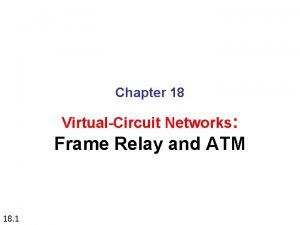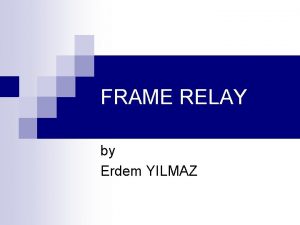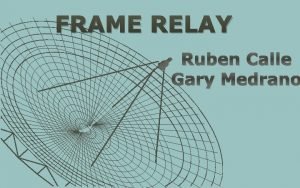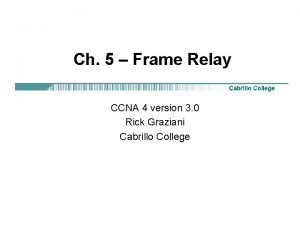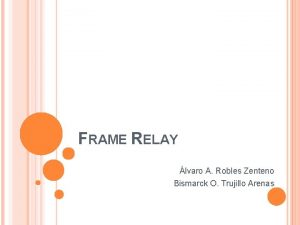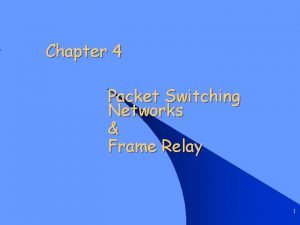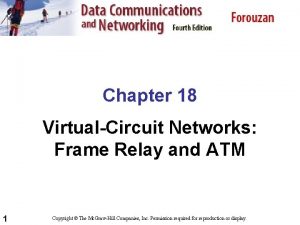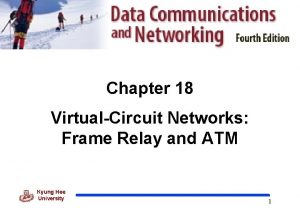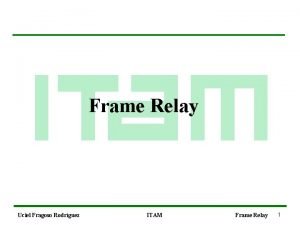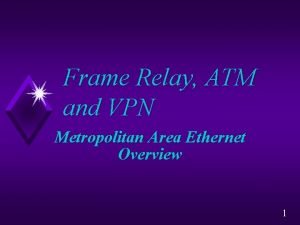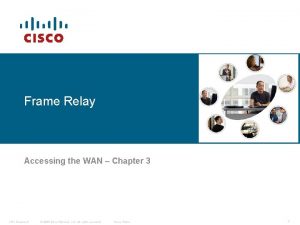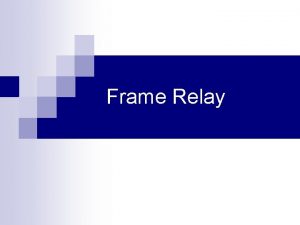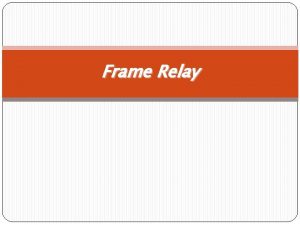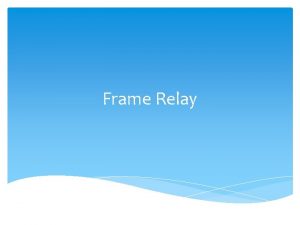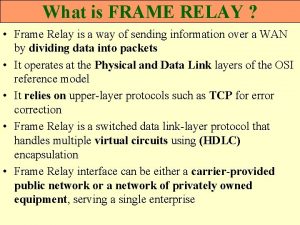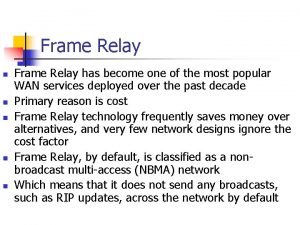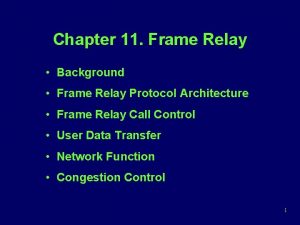Frame Relay Outline Why do we need Frame






















































- Slides: 54

Frame Relay

Outline Why do we need Frame Relay? Frame Relay Network as a NBMA network Virtual Circuits DLCI Mapping of DLCI Frame Relay Frame


Why do we need Frame Relay? Frame Relay is a more complex technology than point -to-point WAN links but also provides more features and benefits

Why do we need Frame Relay? An alternative to dedicated, expensive, leased WAN lines is Frame Relay is a high-performance WAN protocol that operates at the physical and data link layers of the OSI reference model. Frame Relay provides a cost-efficient solution for communications between multiple remote sites by using a single access circuit from each site to the provider.

• The capacity between any two sites can vary.

Frame Relay Network access switches

Frame Relay Network A Frame Relay network is made up of a large number of Frame Relay switches dispersed all over the coverage area of a Frame Relay service provider (e. g. region or country) The switches are interconnected in a complex mesh topology.

Frame Relay Network Frame Relay switches: Terminate user circuits, in addition to connecting to other switches, and are called access switches. Other Frame Relay switches do not terminate user circuits, connecting to other Frame Relay switches only, and make the backbone of the Frame Relay network.

An SVC between the same two DTEs may change. • is temporary connections • is set up dynamically when needed • require call setup and termination for each connection. A PVC between the same two DTEs will always be the same. • A predefined VC. • Is equated to a leased line in concept.

Multiple Virtual Circuits The router or FRAD, connected to the Frame Relay network, may have multiple VCs connecting it to various endpoints.

Multiple Virtual Circuits Multiple VCs on a single physical line are distinguished by assigning each VC an identifier called data-link connection identifiers (DLCI).

DLCI VCs are identified by DLCIs. Frame Relay DLCIs have local significance, that means that their values are unique per router, but not necessarily in the other routers. DLCI values typically are assigned by the Frame Relay service provider.

Frame Relay Switch Frame Relay creates a VC by storing input-port to output-port mapping in the memory of each switch

Frame Relay Address Mapping

Frame Relay Address Mapping Before DLCI can be used to route traffic, it must be associated with the IP address of its remote router

Frame Relay Address Mapping The Head. Quarter will need to map Branch 1 IP address to DLCI 23 & map Branch 2 IP address to DLCI 51. After that it can encapsulate data inside a Frame Relay frame with an appropriate DLCI number and send to the destination.

Mapping of DLCI The mapping of DLCIs to Layer 3 addresses can be handled manually or dynamically. Manually (static): the administrators can statically assign a DLCI to the remote IP address. Dynamic: the router can send an Inverse ARP Request to the other end of the PVC for its Layer 3 address.

Inverse ARP 2 1 Once the router learns from the switch about available PVCs and their corresponding DLCIs, the router can send an Inverse ARP request to the other end of the PVC. (unless statically mapped )

Inverse ARP For each supported and configured protocol on the interface, the router sends an Inverse ARP request for each DLCI. (unless statically mapped) In effect, the Inverse ARP request asks the remote station for its Layer 3 address. At the same time, it provides the remote system with the Layer 3 address of the local system. The return information from the Inverse ARP is then used to build the Frame Relay map.

Now all the routers have a pair of DLCI & IP address of the router at the other end so data can be forwarded to the right destination.

Frame Relay is a data link protocol and the customer router encapsulates each Layer 3 packet inside a Frame Relay frame comprising a header and trailer before it is sent out the access link. The header and trailer used is actually defined by the Link Access Procedure Frame Bearer Services (LAPF) specification

Frame Relay Frame The simple LAPF header was extended to compensate for the absence of a Protocol Type field:

Frame Relay Frame Header DLCI , fields related to congestion management Data – Contains encapsulated upper-layer data Trailer Frame Relay provides no error recovery mechanism. It only provides CRC error detection. You should keep in mind that Frame Relay encapsulation should match on the routers at the two ends of a VC.

Frame Relay Configuration

Outline Building the network and configuring the cloud Basic Frame Relay Configuration Steps Frame Relay Encapsulation Configuring a Static Frame Relay Map

Building the Network

Evaluation

Evaluation

Configuring the cloud ( Frame Relay network) Configure the DLCIs on the all the active serial interfaces of the cloud

Configuring the cloud ( Frame Relay network) Setup the VCs

Basic Frame Relay Configuration Steps

Frame Relay Encapsulation Router(config-if)#encapsulation frame-relay {cisco | ietf} cisco - Default. Use this if connecting to another Cisco router. Ietf Select this if connecting to a non-Cisco router. 33 Rick Graziani graziani@cabrillo. edu

R 1(config)# interface serial 2/0 R 1(config-if)# ip address 10. 0. 0. 1 255. 0. 0. 0 R 1(config-if)# no shutdown R 1(config-if)# encapsulation frame-relay R 2(config)# interface serial 2/0 R 2(config-if)# ip address 10. 0. 0. 2 255. 0. 0. 0 R 2(config-if)# no shutdown R 2(config-if)# encapsulation frame-relay 34

Verifies Frame Relay Configuration

Mapping of DLCI The mapping of DLCIs to Layer 3 addresses can be handled manually or dynamically. Manually (static): the administrators can statically assign a DLCI to the remote IP address. Dynamic: the router can send an Inverse ARP Request to the other end of the PVC for its Layer 3 address.

R 1# show frame-relay map Serial 0 (up): ip 10. 0. 0. 2 dlci 102, dynamic, broadcast, status defined, active • dynamic refers to the router learning the IP address via Inverse ARP Rick Graziani graziani@cabrillo. edu 37

Configuring a Static Frame Relay Map

Configuring a Static Frame Relay Map Use the frame-relay map command to configure static address mapping. Once a static map for a given DLCI is configured, Inverse ARP is disabled on that DLCI. The broadcast keyword is commonly used with the frame-relay map command. The broadcast keyword simplifies the configuration of OSPF for nonbroadcast networks that use Frame Relay. 39

Remote IP Address Rick Graziani graziani@cabrillo. edu 40 Local DLCI


Layer 3 Addressing with Frame Relay Cisco's Frame Relay implementation defines three different options for assigning subnets and IP addresses on Frame Relay interfaces: One subnet containing all Frame Relay DTEs One subnet per VC A hybrid of the first two options

One Subnet Containing All Frame Relay DTEs Is the using of a single subnet for the Frame Relay network. The single-subnet option is typically used when a full mesh of VCs exists.

One Subnet Per VC

One Subnet Per VC The single-subnet-per-VC works better with a partially meshed or star Frame Relay network. The single-subnet-per-VC alternative matches the logic behind a set of point-to-point links. Using multiple subnets instead of one larger subnet wastes some IP addresses, but it overcomes some issues with distance vector routing protocols.

Hybrid Approach Routers 1, 2 , and 3 create a smaller full mesh between each other. This allows Routers 1, 2, and 3 to use one subnet. Is treated as a separate subnet

Hybrid Approach We are going to have both point-to-point and multipoint sub-interfaces. Multipoint interfaces are logical Frame Relay subinterfaces but they can terminate more than one PVCs just like physical serial interfaces.

Frame Relay Subinterfaces Frame Relay can partition a physical interface into multiple virtual interfaces called subinterfaces. A subinterface is simply a logical interface that is directly associated with a physical interface. Therefore, a Frame Relay subinterface can be configured for each of the PVCs coming into a physical serial interface.

Frame Relay Subinterfaces Frame Relay subinterfaces can be configured in either point-to-point or multipoint mode:

Point-to-Point Subinterface A single point-to-point subinterface establishes one PVC connection to another physical interface or subinterface on a remote router. In this case, each pair of the point-to-point routers is on its own subnet, and each point-to-point subinterface has a single DLCI. In a point-to-point environment, each subinterface acts like a separate, conventional point-to-point interface.

Multipoint Subinterface A single multipoint subinterface establishes multiple PVC connections to multiple physical interfaces or subinterfaces on remote routers. All the participating interfaces are in the same subnet.

Assigning IP address to point-to-point subinterfacses

Mapping DLCI in point-to-point subinterfacses

Multipoint subinterface
 Frame relay layers
Frame relay layers Risanuri hidayat
Risanuri hidayat What is frame relay
What is frame relay Hey hey bye bye
Hey hey bye bye Frame relay caracteristicas
Frame relay caracteristicas Frame relay lmi
Frame relay lmi Frame relay ccna
Frame relay ccna Split horizon
Split horizon Frame relay packet tracer
Frame relay packet tracer Frame relay osi
Frame relay osi Frame relay architecture
Frame relay architecture Frame relay and x.25
Frame relay and x.25 Osi bismarck
Osi bismarck Advantages and disadvantages of structural steel
Advantages and disadvantages of structural steel Frame relay packet switching
Frame relay packet switching Frame relay and atm
Frame relay and atm Frame relay vs atm vs mpls
Frame relay vs atm vs mpls Protocolo lapd
Protocolo lapd Pasado de frame
Pasado de frame Frame relay vs vpn
Frame relay vs vpn Frame relay wan
Frame relay wan Transmission mac
Transmission mac Why do you relay
Why do you relay Dont ask
Dont ask Frame by frame animation programs
Frame by frame animation programs Pengertian animasi frame by frame
Pengertian animasi frame by frame It in a sentence
It in a sentence Why architects need to use their ears
Why architects need to use their ears Shylock meaning
Shylock meaning Why do amebas need to obtain food
Why do amebas need to obtain food Why do we need to breathe
Why do we need to breathe Sources of finance
Sources of finance Why we need computer
Why we need computer Why do we need to breathe
Why do we need to breathe Why do we need arrays?
Why do we need arrays? No state can make unreasonable distinctions
No state can make unreasonable distinctions Why cells need energy
Why cells need energy Why do we need to breathe
Why do we need to breathe Agility in tennis
Agility in tennis We need to water
We need to water Why do all organisms need nitrogen
Why do all organisms need nitrogen Why do people need information
Why do people need information Why do we need cracking
Why do we need cracking Tissue bordering the root and sides of fingernail
Tissue bordering the root and sides of fingernail Nature and aims of business
Nature and aims of business Why do all organisms need food
Why do all organisms need food Need of constitution
Need of constitution Why do animals need a nervous system
Why do animals need a nervous system Which mechanism helps in size separation by sieve shaker?
Which mechanism helps in size separation by sieve shaker? Why do people need information
Why do people need information Why do cells need oxygen?
Why do cells need oxygen? Why do plants need roots
Why do plants need roots Element of indian ethos
Element of indian ethos Why we need electricity
Why we need electricity Why we need sleep
Why we need sleep
